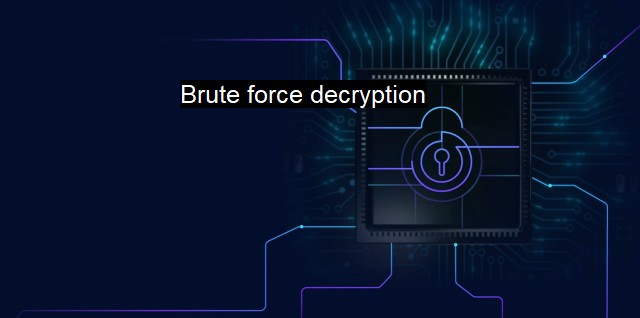What is Brute force decryption?
Unleashing the Power of Brute Force Decryption in Cybersecurity: A Double-Edged Sword
"Brute force decryption" is a critical aspect and a notorious attempt to undermine the robustness of secure systems within the cybersecurity space. In its simplest form, it is a type of cyberattack in which the attacker aims to decode encrypted data by trying every possible decryption key or password until the correct one is discovered. Given that the number of potential keys depends on the applicable encryption algorithm and key length, the higher the number of prospects, the more difficult the brute force decryption becomes.The name "brute force" describes the trial-and-error methodology of decryption rather aptly. There is little sophistication or finesse involved; it is rather a 'hit and hope' approach undertaken by the 'attacker'. To this effect, strong encryption techniques and large encryption keys can exponentially extend the time an attacker would need to decipher the coded information, ever-reducing the practicality of a brute force attack in real terms.
To perform a brute force encryption, attackers need two things: an encrypted message, and the encryption system used by the targeted individual or organization. The attacker will apply every possible key to the system until they unearth the one capable of unlocking the encoded data. The feature-less attribute and broad-based logic of the attack render approximately every system using encryption technology as a plausible target.
As the variety of keys that can be used is generally known, what makes brute force attacks challenging is the sheer volume of possible combinations that can come from permutations of those identifiable keys used in encryption systems. This large number directly translates to a considerable amount of time and computational resources to guess the correct cipher, sometimes massive enough to be practically unattainable for an attacker.
One of the primary obstacles standing in the way of the widespread efficacy of brute force decryption strategies is cryptographic protocols' progression. Modern encryption standards, such as Advanced Encryption Standard (AES), use keys that are large enough to render brute force attacks virtually ineffective through increased complexity and length. A 128-bit key in AES-128, for instance, can result in around 3.4x10^38 potential combinations. Several permutations of the potential keys magnify the complexity to an even greater degree in its robust forms i.e., AES-192 and AES-256, which exploit 192-bit and 256-bit keys, respectively.
That said, computational capabilities and processing speeds continue to advance at potent rates. In a world dominated by quantum computers, the time required to brute force a password would reduce significantly. so far, brute force techniques' lack of timeliness render them convoluted and largely impotent in the face of robust, modern cybersecurity countermeasures.
To counter such brute force decryption attempts, many activity monitoring and intrusion protection mechanisms are widely deployed within secure systems. After identifying numerous unsuccessful decryption efforts, these protection systems either slow down their system response or even lock the attacker out, reducing the odds that a brute force attack is effective.
Maintaining longer encryption keys and employing complex passwords significantly reduces the chances of successful brute force decryption, exponentially increasing the attack's computational effort. Using two-factor or multi-factor authentication methods can further complicate brute force decryption measures. Still, these measures will not prevent an attacker from trying but essentially aim to make a successful break near to impossible. Regular updates of encryption algorithms and passkeys further beef up the defense against attackers.
While brute force decryption is a possible and significant threat within the cybersecurity realm, advancements in encryption protocols and protective countermeasures make it a generally ineffective method against robust, secure systems. As the adage goes, the best defense is a proactive offense; understanding the implications and potential impacts of brute force attacks can help organizations best prepare to thwart such breach attempts and stay a step ahead in the game of cybersecurity.

Brute force decryption FAQs
What is brute force decryption?
Brute force decryption is an attack method used in cybersecurity to crack passwords and encryption by trying all possible combinations of characters until the correct one is discovered.Why is brute force decryption a concern for antivirus software?
Brute force decryption is a concern for antivirus software because it can be used to break through encryption used to protect malware files. This can allow attackers to create files that are undetectable by antivirus software.How can I protect my computer from brute force decryption attacks?
To protect your computer from brute force decryption attacks, use strong passwords and encryption methods. It is also important to keep your system and antivirus software up to date with the latest security patches.Is brute force decryption illegal?
In most situations, attempting to brute force decryption on a system or file that you do not own is illegal. However, some organizations may use brute force decryption as a legitimate security measure to test and strengthen their own systems.| | A | | | B | | | C | | | D | | | E | | | F | | | G | | | H | | | I | | | J | | | K | | | L | | | M | |
| | N | | | O | | | P | | | Q | | | R | | | S | | | T | | | U | | | V | | | W | | | X | | | Y | | | Z | |
| | 1 | | | 2 | | | 3 | | | 4 | | | 7 | | | 8 | | |||||||